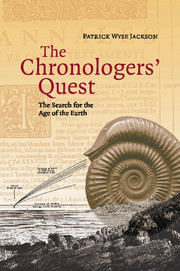Book contents
- Frontmatter
- Contents
- List of illustrations
- List of tables
- Preface
- Acknowledgements
- 1 The ancients: early chronologies
- 2 Biblical calculations
- 3 Models of Aristotelian infinity and sacred theories of the Earth
- 4 Falling stones, salty oceans, and evaporating waters: early empirical measurements of the age of the Earth
- 5 Thinking in layers: early ideas in stratigraphy
- 6 An infinite and cyclical Earth and religious orthodoxy
- 7 The cooling Earth
- 8 Stratigraphical laws, uniformitarianism and the development of the geological column
- 9 ‘Formed stones’ and their subsequent role in biostratigraphy and evolutionary theory
- 10 The hour-glass of accumulated or denuded sediments
- 11 Thermodynamics and the cooling Earth revisited
- 12 Oceanic salination reconsidered
- 13 Radioactivity: invisible geochronometers
- 14 The Universal problem and Duck Soup
- Bibliography
- Index
5 - Thinking in layers: early ideas in stratigraphy
Published online by Cambridge University Press: 02 December 2009
- Frontmatter
- Contents
- List of illustrations
- List of tables
- Preface
- Acknowledgements
- 1 The ancients: early chronologies
- 2 Biblical calculations
- 3 Models of Aristotelian infinity and sacred theories of the Earth
- 4 Falling stones, salty oceans, and evaporating waters: early empirical measurements of the age of the Earth
- 5 Thinking in layers: early ideas in stratigraphy
- 6 An infinite and cyclical Earth and religious orthodoxy
- 7 The cooling Earth
- 8 Stratigraphical laws, uniformitarianism and the development of the geological column
- 9 ‘Formed stones’ and their subsequent role in biostratigraphy and evolutionary theory
- 10 The hour-glass of accumulated or denuded sediments
- 11 Thermodynamics and the cooling Earth revisited
- 12 Oceanic salination reconsidered
- 13 Radioactivity: invisible geochronometers
- 14 The Universal problem and Duck Soup
- Bibliography
- Index
Summary
The late Roman Catholic Bishop of Kilfenora, a tiny diocese in County Clare in western Ireland, was responsible on 23 October 1988 for beatifying another bishop and elevating him to the position of Blessed, the first step along the time-consuming path to sainthood. It would be unusual, one might think, for a minor bishop to have such power, but not when you discover that amongst the Bishop of Kilfenora's other sees is that of Rome. This bishop was none other than John Paul II, the late Pope, who had been responsible during his pontificate for creating more saints and beatifying more persons than did his five predecessors combined. In total Pope John Paul II canonised 469 people and beatified over 1,300 more. The subject of the autumn 1988 ceremony held in Rome was Nikolas (or Niels or Nicolaus) Stensen, the Titular Bishop of Titiopolitan, whom geologists and historians of science are more likely to remember by the Latin version of his name, Steno. Geologists revere him as the ‘father of geology’, and his ideas gave rise to what has been labelled by some ‘the Stenonian Revolution’ in geology.
STENO AND THE TUSCAN LANDSCAPE: TURNING THE KEY TO THE CONCEPT OF STRATIFICATION
Nikolas Stensen (Figure 5.1) was born in Copenhagen, Denmark, on 20 January 1638 and died 48 years later in Germany on 25 November 1686. In that comparatively short time he achieved much in several fields: in medicine, natural history and in the church.
- Type
- Chapter
- Information
- The Chronologers' QuestThe Search for the Age of the Earth, pp. 66 - 85Publisher: Cambridge University PressPrint publication year: 2006



